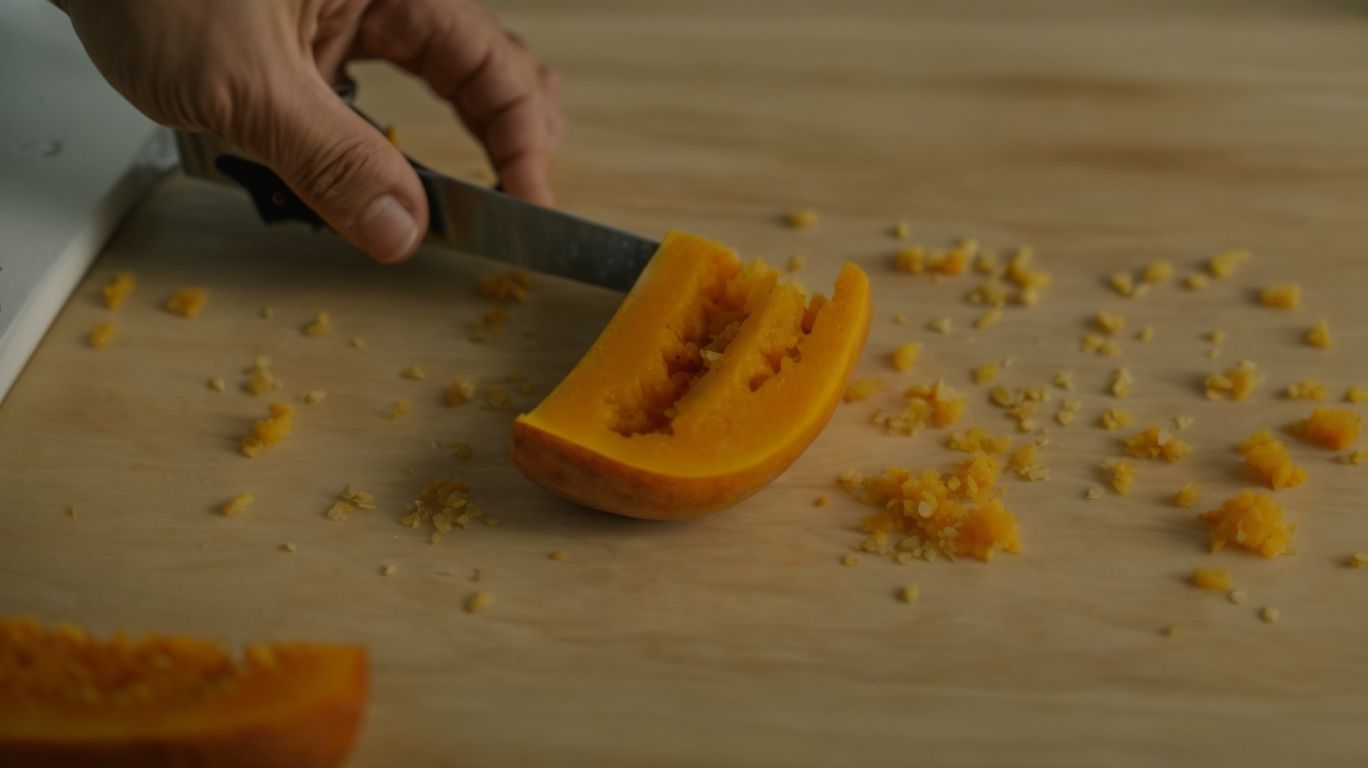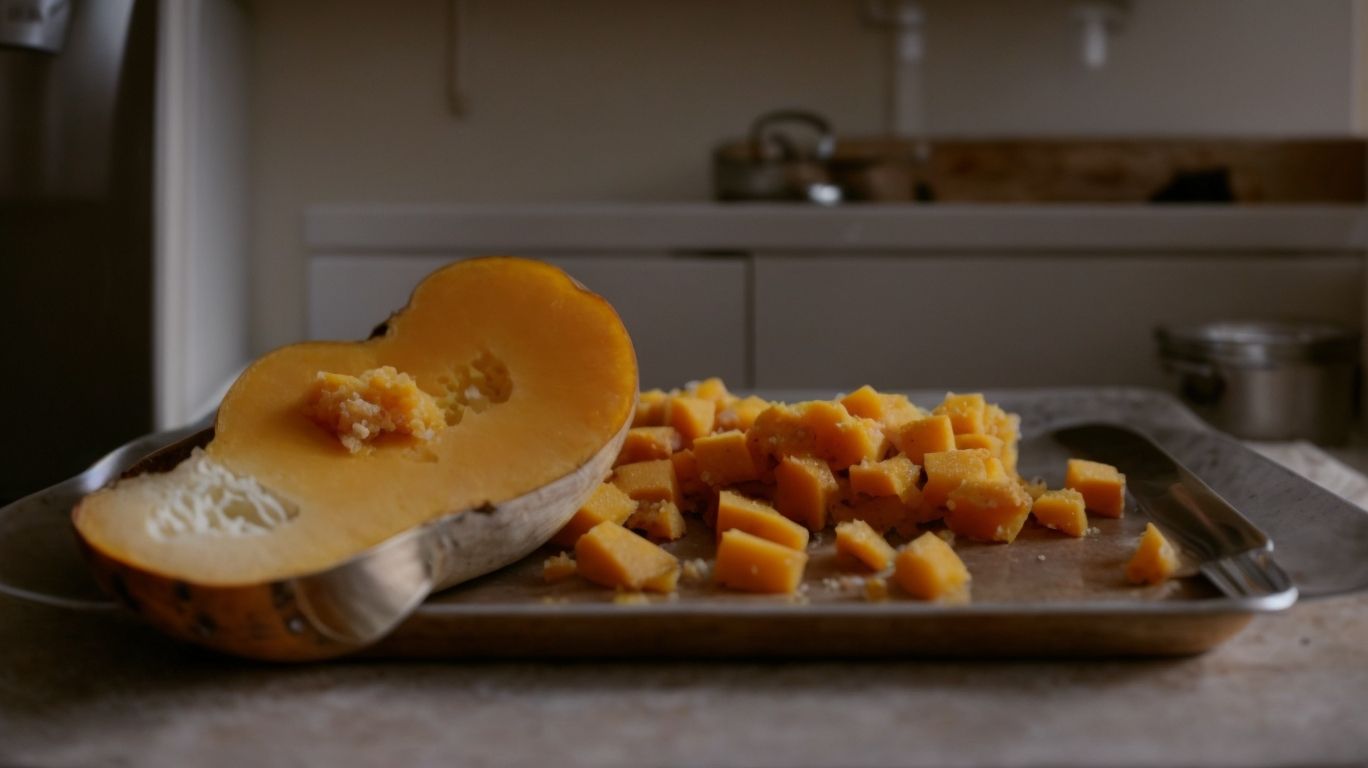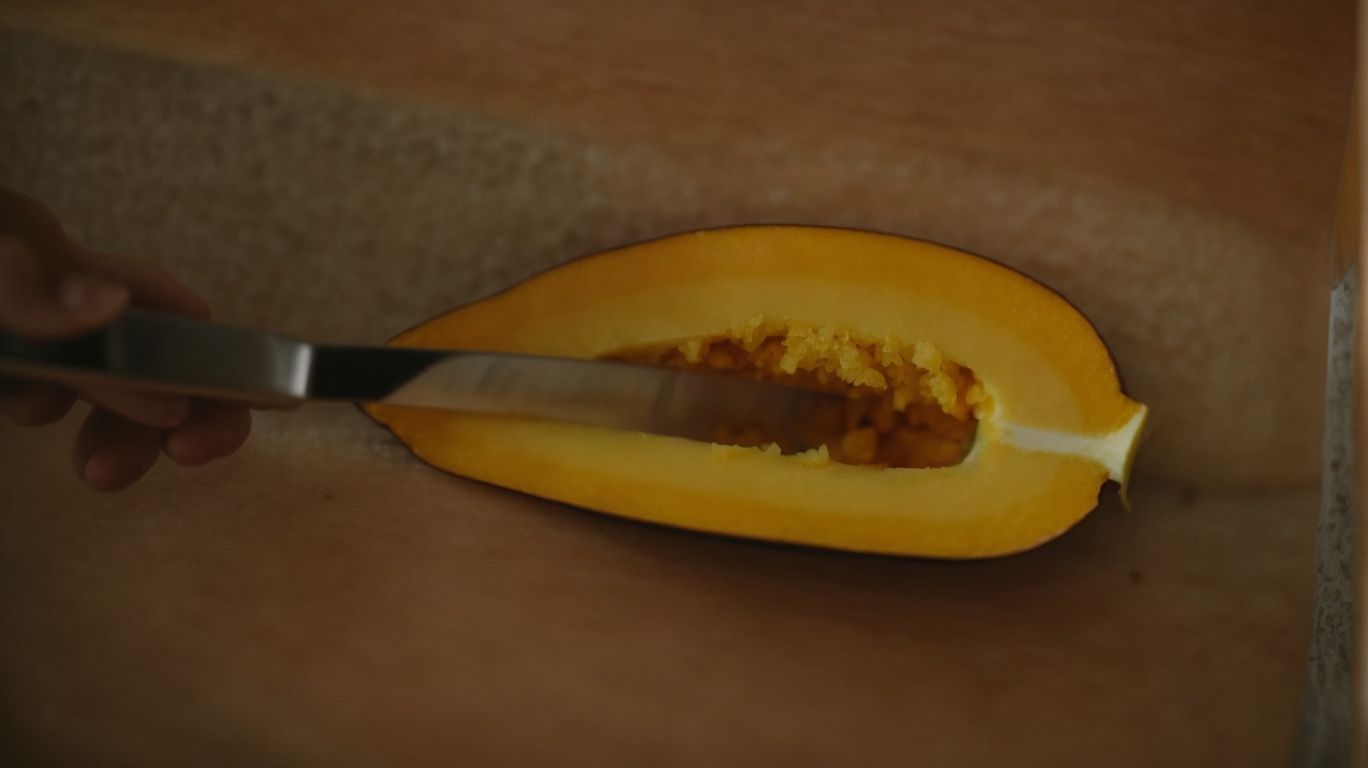How to Bake Butternut Squash?
Are you looking to add a delicious and nutritious vegetable to your meals? Look no further than butternut squash!
In this article, we will explore everything you need to know about baking butternut squash. From choosing the perfect squash to storing and preparing it for baking, we’ve got you covered.
We will also discuss different baking methods, tips, and serving suggestions to help you create mouth-watering dishes with this versatile ingredient.
So, grab your apron and let’s get baking!
Key Takeaways:
What is Butternut Squash?
Butternut squash is a popular winter squash known for its sweet, nutty flavor and vibrant orange color. It is often used in various dishes, including soups and roasted vegetable medleys.
When you cook butternut squash, its flesh becomes tender and creamy, making it a versatile ingredient in both sweet and savory recipes. Its flavor profile, often described as a mix of sweet potato and pumpkin, pairs well with warming spices like cinnamon, nutmeg, and ginger. This squash variety is abundant in fall, making it a staple ingredient in seasonal dishes. Besides soups, butternut squash is also commonly used in risottos, salads, and as a side dish.
Why Bake Butternut Squash?
Baking butternut squash offers a simple and delicious way to enhance its natural sweetness and create a caramelized, roasted flavor profile that complements various seasonings and ingredients.
Roasting the butternut squash in the oven brings out its rich flavors and transforms the texture into a creamy consistency that adds depth to your dishes. This method not only intensifies the sweetness of the squash but also enhances its nutty undertones, making it a versatile ingredient for both savory and sweet recipes.
Baking the butternut squash helps retain its nutrients, such as vitamin A, vitamin C, and potassium, making it a nutritious addition to your meals.
Preparing the Squash for Baking

Credits: Poormet.Com – Randy Adams
Before baking butternut squash, it is essential to properly prepare the squash by peeling, seeding, and cutting it into desired shapes for roasting.
Start by washing the butternut squash thoroughly under running water to remove any dirt or debris. Next, using a sharp peeler, carefully peel off the tough outer skin of the squash, making sure to remove all the green parts.
Once peeled, slice the squash in half lengthwise and scoop out the seeds and stringy pulp using a spoon. Discard the seeds or save them for roasting separately. Then, place the squash halves flat side down on a cutting board and proceed to cut them into uniform cubes or slices depending on your recipe requirements.
Remember to preheat the oven and prepare a baking sheet by either lining it with parchment paper or lightly greasing it to prevent sticking. Arrange the cut squash pieces on the baking sheet in a single layer to ensure even roasting and delicious caramelization.
How to Choose the Perfect Butternut Squash?
Selecting the perfect butternut squash involves looking for a firm, unblemished skin with a consistent tan color and a hefty weight, indicating a ripe and flavorful squash.
When choosing your butternut squash, ensure the skin is free of soft spots or cuts, as these could indicate spoilage. A uniform tan color suggests that the squash ripened evenly, enhancing its sweetness and texture when cooked. A heavier squash typically means more flesh and consequently more flavor, making it ideal for soups, roasting, or purees. Remember that a good-quality butternut squash offers a rich, nutty taste profile and a smooth texture, setting the stage for delightful culinary creations.
How to Store Butternut Squash?
To store butternut squash, keep it in a cool, dry place away from direct sunlight. Avoid storing it in the refrigerator as the humidity can cause spoilage. Optionally, you can store cut squash in the fridge wrapped in a damp paper towel to maintain freshness.
Consider the ideal temperature range for storing butternut squash, which is around 50-55°F (10-13°C). This stable environment helps preserve the squash’s texture and flavor. Ensure proper ventilation to prevent mold growth and extend the shelf life. A pantry or cellar with good air circulation is an excellent choice for long-term storage.
How to Peel and Cut Butternut Squash?
Peeling and cutting butternut squash involves using a sharp chef’s knife to remove the skin and then cubing the flesh into uniform pieces for even roasting. Alternatively, you can peel the squash with a vegetable peeler before dicing it into cubes.
When selecting a butternut squash, look for one that feels heavy for its size and has a firm, unblemished skin. To begin the peeling process, use a vegetable peeler to remove the tough outer skin. Taking care to avoid your fingers, run the peeler along the squash’s length in smooth, even motions until all the skin is removed. Once peeled, carefully cut off the top and bottom ends of the squash with your chef’s knife to create stable flat surfaces for further cutting.
Next, halve the squash lengthwise to reveal the seeds and fibrous core. Using a spoon, scrape out the seeds and stringy pulp, leaving only the solid flesh. Proceed to slice each squash half into long strips, then crosswise into even cubes. A uniform size ensures that the squash cooks evenly, preventing some pieces from being undercooked while others are overdone.
Baking Methods for Butternut Squash
There are various baking methods for butternut squash, including roasting in the oven until tender and achieving a deliciously roasted flavor that enhances its natural sweetness.
Oven roasting is often the preferred technique for cooking butternut squash due to its ability to bring out the vegetable’s rich, caramelized notes while maintaining a tender consistency.
This method involves cutting the squash into evenly sized pieces, drizzling them with olive oil, seasoning with salt, pepper, and any desired herbs or spices, then placing them on a baking tray.
It’s essential to monitor the squash’s texture throughout the roasting process to ensure it doesn’t become mushy or overly dry. Adjusting the cooking time according to the size of the squash pieces can help achieve the desired results.
Baking Whole Butternut Squash
Baking a whole butternut squash can simplify the preparation process and intensify its natural flavor by allowing it to cook in its skin, resulting in a tender and aromatic dish.
When the butternut squash is roasted whole, the skin helps to trap moisture and flavors within the vegetable, creating a rich and flavorful outcome. This method not only enhances the taste but also preserves the nutrients present in the squash, making it a wholesome choice for any meal.
Baking Sliced Butternut Squash
Slicing butternut squash before baking offers a simple and elegant presentation, allowing for quicker cooking times and versatile seasoning options to enhance its natural flavors.
When preparing this delightful vegetable, start by cutting off the ends to create a stable base. Then, peel the tough skin using a sharp knife or vegetable peeler. Carefully slice the squash lengthwise, removing the seeds with a spoon or melon baller.
- For seasoning, a classic combination of olive oil, salt, and pepper works wonders, or you can go for a bolder flavor profile with spices like cinnamon, cumin, or paprika.
Baking Cubed Butternut Squash
Cubing butternut squash before baking results in golden brown, caramelized edges that enhance its buttery taste and roasted flavor. This method is ideal for creating tender and flavorful roasted vegetables.
When you cube butternut squash for baking, you’re not just creating visual appeal with those beautifully caramelized edges, but you’re also intensifying its flavor profile. The surface area increases during cubing, allowing more caramelization to occur, bringing out a natural sweetness in the squash.
The texture of cubed butternut squash transforms wonderfully when baked. The exterior crisps up nicely while the interior remains moist and tender, providing a delightful contrast in every bite.
Not to mention, the caramelization deepens the squash’s natural sweetness and contributes to that delicious roasted flavor that pairs so well with a variety of dishes. So, if you’re looking to elevate the taste and texture of your roasted vegetables, cubing your butternut squash is a simple yet effective technique to consider.
Baking Tips and Tricks

Credits: Poormet.Com – Benjamin Johnson
Enhance the flavor of baked butternut squash by using a variety of seasonings such as cinnamon, maple syrup, and fresh rosemary to create a festive and aromatic dish that is both healthy and delicious.
Regarding seasoning your baked butternut squash, experimenting with seasonal spices like nutmeg, ginger, and allspice can elevate the taste profile to a whole new level. These spices not only add warmth and depth but also provide a subtle sweetness that complements the natural sweetness of the squash.
To really enhance the flavors, consider incorporating a touch of orange zest for a citrusy twist or a sprinkle of nutritional yeast for a savory, umami-rich note. These additions can bring a unique dimension to the dish, making it a standout at any festive gathering.
Adding Flavor to Butternut Squash
Adding flavor to butternut squash can be achieved by incorporating ingredients like butter, maple syrup, and warm spices such as cinnamon to create a rich and aromatic dish that is perfect for a holiday side dish.
When you combine the creamy richness of butter with the sweet depth of maple syrup, and the warm, earthy notes of cinnamon, you elevate the natural sweetness of the butternut squash to a whole new level. The butter adds a luxurious texture, the maple syrup brings a subtle sweetness, and the cinnamon provides a cozy, comforting flavor profile.
The vibrant colors of the squash combined with the golden glaze from the syrup and the speckles of cinnamon make for a visually appealing dish, perfect for festive occasions. Not only does it taste incredible, but it also adds a touch of elegance to your table setting.
How to Prevent Overcooking Butternut Squash?
To prevent overcooking butternut squash, monitor its tenderness and texture throughout the baking process, ensuring that it remains firm yet fork-tender to preserve its natural flavors and nutrients.
One key technique to achieve this delicate balance is to periodically insert a fork into the squash to assess its doneness. The ideal outcome is when the fork can easily penetrate the flesh with minimal resistance, indicating that it is ready. Be cautious not to leave it in the oven for too long, as an overcooked squash can turn mushy and lose its distinct texture.
How to Tell When Butternut Squash is Done?
Knowing when butternut squash is done involves observing its roasted vegetable appearance, tender flesh, and the ease with which a fork pierces through the skin. These indicators signal that the squash is perfectly roasted and ready to be enjoyed.
When the butternut squash is cooked to perfection, the flesh should be soft and easily mashable, indicating that it is cooked all the way through. The roasted appearance adds a depth of flavor and caramelization to the vegetable, enhancing its sweetness. The skin of the squash plays a crucial role; it should be wrinkled and slightly golden, showing that it has become tender and easy to eat along with the flesh. By paying attention to these cues, you can ensure a delectable butternut squash dish every time.
Serving Suggestions for Baked Butternut Squash
Baked butternut squash can be served in various ways, including as a simple side dish with salt, pepper, and a drizzle of maple syrup, or incorporated into elegant recipes like butternut squash ravioli for a more sophisticated presentation.
For a twist on traditional roasting, try stuffing the squash with a savory mixture of quinoa, mushrooms, and fresh herbs before baking to create a hearty main dish.
Another delicious option is to puree the roasted squash into a creamy soup with hints of nutmeg and thyme, perfect for cozy autumn evenings.
In more extravagant settings, consider serving butternut squash gratin with layers of creamy cheese and breadcrumbs for a rich and indulgent side dish that will impress any guest.
Savory Baked Butternut Squash Recipes
Savor the rich and savory flavors of baked butternut squash with recipes that feature a perfect balance of salt, pepper, and other complementary seasonings to elevate the natural taste of this versatile vegetable.
Enhance the natural sweetness of butternut squash by adding a touch of honey or maple syrup before baking, creating a delightful caramelized glaze that pairs beautifully with the savory elements. For a more robust flavor profile, consider incorporating warming spices like cumin or paprika for a unique twist on classic butternut squash preparation.
For those with a preference for a more herby taste, experiment with fresh rosemary, thyme, or sage to infuse the squash with fragrant notes that complement its rich texture. Alternatively, a sprinkle of cayenne pepper or chili flakes can add a subtle heat to balance out the sweetness of the vegetable.
Sweet Baked Butternut Squash Recipes
Indulge in the sweetness of baked butternut squash with delightful recipes that transform this side dish into a delectable treat, often incorporating ingredients like maple syrup, cinnamon, and a hint of rosemary for a flavorful twist.
Maple syrup adds a rich, caramel-like sweetness to the roasted butternut squash, balancing perfectly with the warm notes of cinnamon and the earthy aroma of rosemary.
The combination of these ingredients creates a harmonious blend of flavors, making each bite a delightful experience for those with a penchant for sweet treats.
Whether served as a cozy winter dessert or a unique side dish for a special occasion, these baked butternut squash recipes are sure to impress even the most discerning palates.
Frequently Asked Questions
How to Bake Butternut Squash: Tips and Tricks
What is the Best Way to Bake Butternut Squash?
How Long Does it Take to Bake Butternut Squash?
Can I Bake Butternut Squash in Advance?
What Are Some Creative Ways to Serve Baked Butternut Squash?
Is Baked Butternut Squash a Nutritious Dish?
How to Bake Butternut Squash: Tips and Tricks
To achieve a perfectly baked butternut squash, make sure to cut it evenly, use a sharp knife, and season it well. Also, placing the squash cut-side down on the baking tray will help it cook evenly and retain its moisture.
What is the Best Way to Bake Butternut Squash?
The best way to bake butternut squash is to cut it into cubes and bake it in the oven at 400 degrees Fahrenheit for about 25-30 minutes. This method allows the squash to cook evenly and develop a delicious caramelized texture.
How Long Does it Take to Bake Butternut Squash?
The baking time for butternut squash will vary depending on how you cut it and the size of the squash. Generally, it takes about 25-35 minutes at 400 degrees Fahrenheit for cubed squash, and 45-50 minutes for a whole squash. It’s best to check for doneness by piercing the squash with a fork.
Can I Bake Butternut Squash in Advance?
Yes, you can bake butternut squash in advance. Once it’s baked, let it cool completely, then store it in an airtight container in the fridge for up to 3 days. You can reheat it in the oven or microwave when ready to serve.
What Are Some Creative Ways to Serve Baked Butternut Squash?
Baked butternut squash can be served as a side dish, added to salads, or used in soups and stews. You can also top it with a delicious sauce, such as a maple glaze or a garlic herb butter, to elevate its flavor.
Is Baked Butternut Squash a Nutritious Dish?
Yes, baked butternut squash is a nutritious dish. It’s a great source of vitamins A and C, as well as potassium and fiber. It’s also low in calories and can be a healthy addition to any meal.

